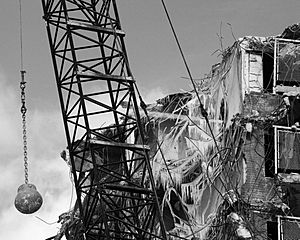Demolition facts for kids
Demolition is the process of safely tearing down buildings and other structures. It's different from deconstruction, which means carefully taking a building apart to save and reuse its materials. Demolition is needed when a building is old, unsafe, or when new construction is planned.
For smaller buildings, like houses, demolition is often quite simple. Workers might use large machines such as excavators, bulldozers, or small cranes to pull the building down. Special tools can also be used. Larger buildings, especially those made of brick or stone, might be taken down using a wrecking ball swung by a crane.
Contents
How Building Implosion Works
For very large buildings, tall chimneys, bridges, or even some smaller structures, experts sometimes use a method called building implosion. This involves using carefully placed explosives. The goal is to make the building fall inward, collapsing into its own space. This prevents damage to nearby buildings.
Imploding a structure is very quick. The actual collapse only takes a few seconds. Skilled experts plan the implosion carefully to make sure the building falls exactly where they want it to. This method is very useful for tall buildings in busy city areas.
Safety During Implosion
While exciting to watch, building implosion has some risks. If something goes wrong, it can cause serious damage to nearby structures. Flying debris is a major danger, so the area must be cleared and protected.
Sometimes, a building might not collapse completely. This leaves a structure that is unstable and dangerous for workers. Also, a strong air shock wave can happen during an implosion. If the sky is cloudy, this wave can spread outwards, potentially breaking windows in surrounding buildings. Experts like Stephanie Kegley explain that clouds can make the shock wave spread out instead of going up into the sky.
Even though it's spectacular, controlled implosion is usually a last resort. It's only used when other demolition methods are too hard or too expensive.
Getting Ready for Implosion
Preparing a building for implosion takes a lot of time, often several weeks or months. First, anything valuable inside, like copper wires, is removed. Materials that could become dangerous, like glass, or those that could spread widely, like insulation, are also taken out. Inside walls that don't support the building are removed.
Then, small holes are drilled into certain support columns where explosives are placed. These explosives can include substances like nitroglycerin or C4. Smaller columns and walls might be wrapped with a special cord that detonates. The goal is to use as little explosive as possible to make the building collapse safely. Areas with explosives are covered with thick fabric and fencing to catch any flying pieces. After the implosion, cleaning up the site and hauling away the debris takes much longer than the demolition itself.
Deconstruction: A Green Approach
A newer, more environmentally friendly way to take buildings apart is called deconstruction. The main idea is to send as little material as possible to landfills. This "green" method involves carefully removing materials like wood, metal, and concrete, and separating them. These materials can then be reused or recycled.
With good planning, deconstruction can save over 90% of a building's materials from going to waste. It also greatly reduces the amount of CO2 emissions compared to traditional demolition.
New machines and equipment make it easier to sort different types of waste right at the construction site. For example, demolished concrete can be crushed and reused as a base for new buildings or even mixed into new concrete. Wood waste can be shredded and composted, or used to make new wood products like MDF.
Safety is always the most important thing. A safety officer is usually on site to make sure all rules are followed.
Other Demolition Methods
Besides explosives, some companies use very precise methods like diamond wire sawing. These services are used when a building needs to be taken apart with extreme accuracy.
Related pages
Images for kids
See also
 In Spanish: Demolición para niños
In Spanish: Demolición para niños












